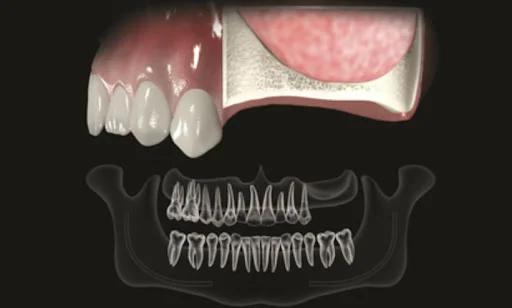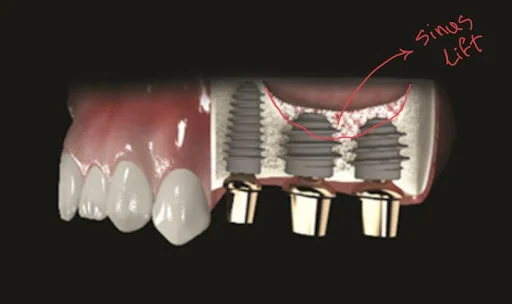BONE GRAFTING AND SINUS LIFTING
The key to a successful and long-lasting implant is the quality and quantity of the bone to which the implant will be attached. In some instances, there may not be enough bone or anatomical features to support the placed implant in the area. A Sinus lift procedure may be necessary to raise the sinus floor and add additional bone to the area for a future implant procedure. Throughout this process, Dr. Dowlatshahi can help you enjoy a comfortable, minimally invasive, and virtually pain-free dental surgery experience.


SINUS LIFTING SURGERY
The maxillary sinuses are located above the upper jaw and behind the nose. These air containing cavities inside the bone help with air flow and sound resonation as well as making the jaw lighter for our bodies to tolerate.
When we have missing teeth in the upper jaw, the sinuses start to grow downwards toward the alveolar crest which eventually results in occupying the tooth space that is empty. Therefore it will lead to bone reduction in the free space of the missing tooth. In this case we need to place a dental implant through a dental implant surgery named bone grafting and sinus lifting surgery. In this procedure the sinus wall is lifted and filled with bone grafting material to hold the implant in the exact and accurate place. Sinus lifting surgery can be done before or during the dental implant surgery.
Sinus Lifting and Bone Grafting surgery will be performed under profound local anesthesia which makes the whole process painless. After the anesthesia wears off the amount of pain a patient can have is similar to a tooth extraction surgery. Professional dentists might prescribe antibiotics in addition to a painkillers and recommend to use a cold compress duringthe first day after the surgery in order to reduce and prevent the possible post-op swelling and pain.
Frequently Asked Questions
The maxillary sinuses are located above the upper jaw and behind the nose. These air containing cavities inside the bone help with air flow and sound resonation as well as making the jaw lighter for our bodies to tolerate.
When we have missing teeth in the upper jaw, the sinuses start to grow downwards toward the alveolar crest. Occupying the tooth space which is empty, reducing the remaining bone available in the area of the missing tooth, to place an implant. So when an implant needs to be placed, it will require a surgery called sinus lifting. In this procedure the sinus wall is lifted and filled with bone grafting material to hold the implant in place. Sinus lifting can be done before or during the implant surgery.
This surgery will be performed under profound local anesthesia. After the anesthesia wears off the amount of pain is similar to a tooth extraction. Your dentist might prescribe antibiotics in addition to painkillers. Using a cold compress during the first day after surgery will greatly help to reduce and prevent the possible post-op swelling.
Bacterial plaque around the gum line and tooth surfaces is one of the most critical factors that can lead to implant failure. Bacterial plaque/ debris can cause gum inflammation, leading to bone loss around your dental implant. This bone loss can lead to implant failure and defeat.
Which amplifies the importance of optimal oral hygiene:
- Brushing twice a day and flossing,
- 3- 6 month checkups and
- Regular six month dental cleanings will remove the bacterial plaque, maintaining a healthy oral and periodontal environment for your implants.
